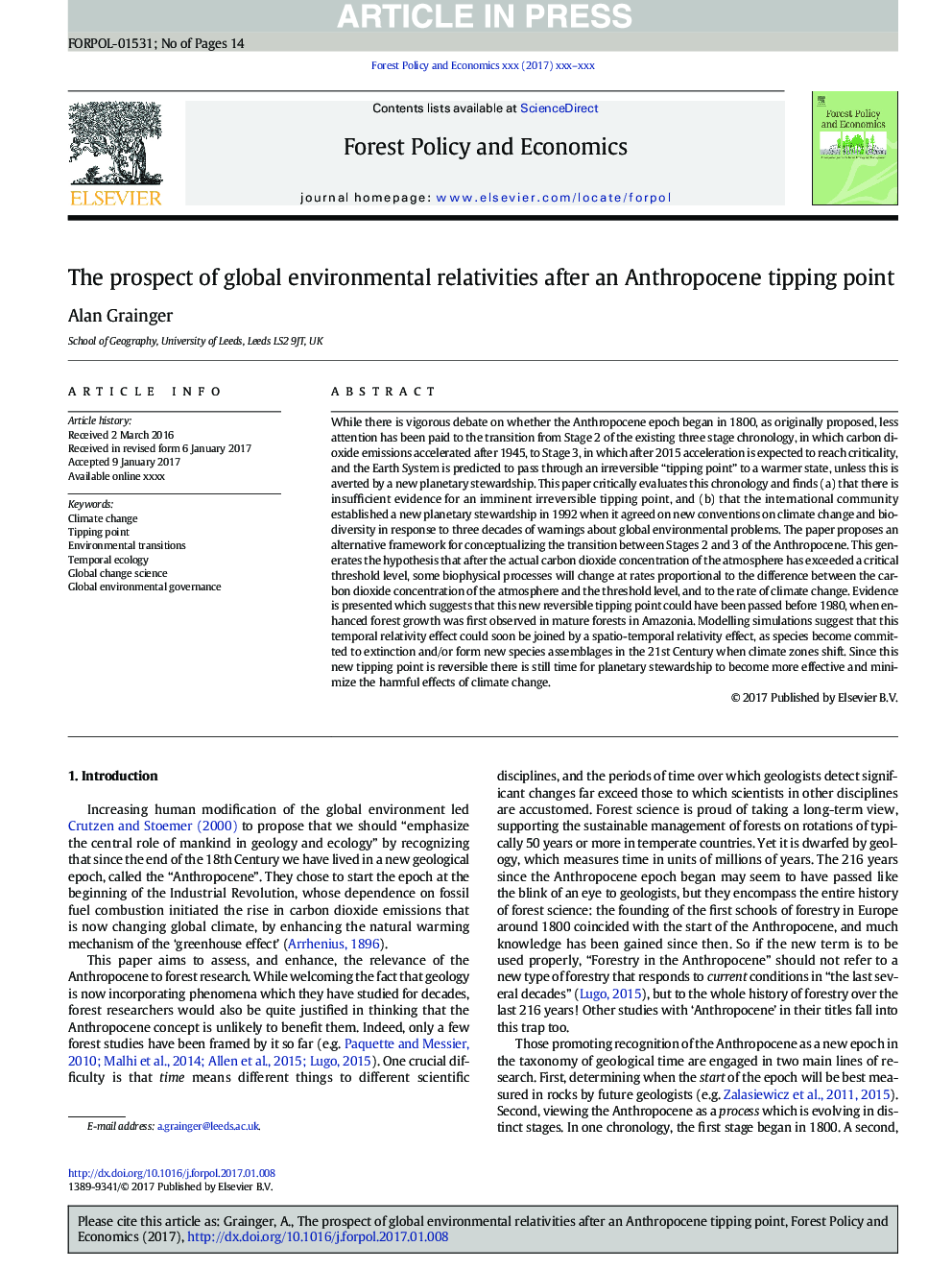| کد مقاله | کد نشریه | سال انتشار | مقاله انگلیسی | نسخه تمام متن |
|---|---|---|---|---|
| 4759791 | 1421660 | 2017 | 14 صفحه PDF | دانلود رایگان |
عنوان انگلیسی مقاله ISI
The prospect of global environmental relativities after an Anthropocene tipping point
ترجمه فارسی عنوان
چشم انداز نسبیت های زیست محیطی جهانی پس از نقطه اوج آلودگی آنتروپوکسن
دانلود مقاله + سفارش ترجمه
دانلود مقاله ISI انگلیسی
رایگان برای ایرانیان
کلمات کلیدی
تغییر آب و هوا، نقطه اوج، انتقال محیط زیست، زیست محیطی زمانی، تغییر علم جهانی، مدیریت جهانی محیط زیست،
ترجمه چکیده
در حالی که بحث جدی در مورد اینکه آیا دوره انترپوسین در سال 1800 آغاز شد، همانطور که در ابتدا پیشنهاد شد، توجه کمتر به انتقال از مرحله 2 دوره زمانی سه مرحله ای که در آن انتشار گاز دی اکسید کربن بعد از 1945، به مرحله 3، در انتظار می رود که شتاب بعد از سال 2015 به بحرانی برسد و سیستم زمین پیش بینی می شود که از طریق یک معکوس برگشت ناپذیر عبور کند؟ به حالت گرمتر، مگر اینکه توسط یک نظارت جدید سیاره ای جلوگیری شود. این مقاله انتقادی از این دوره زمانی را ارزیابی می کند و می رساند (الف) این است که شواهد کافی برای یک نقطه ناپایدار غیرقابل برگشت ناپذیر وجود دارد و (ب) جامعه بین المللی در سال 1992 هنگامی که در کنوانسیون های جدید در مورد تغییرات اقلیمی و تنوع زیستی پاسخ به سه دهه هشدار درمورد مشکلات محیطی جهانی. این مقاله یک چارچوب جایگزین برای مفهوم سازی انتقال بین مراحل 2 و 3 آنتروپوژن ارائه می دهد. این فرضیه را ایجاد می کند که پس از غلظت دی اکسید کربن واقعی جو از یک سطح آستانه انتقادی فراتر رفته است، برخی از فرایندهای بیوفیزیکی با نرخی متناسب با تفاوت بین غلظت دی اکسید کربن جو و سطح آستانه تغییر خواهد کرد و به نرخ تغییر آب و هوا شواهد ارائه شده است که نشان می دهد که این نقطه جدید معکوس برگشت پذیر می تواند قبل از سال 1980، هنگامی که رشد جنگل افزایش یافت، در ابتدا در جنگل های بالغ در آمازون مشاهده شد. شبیه سازی های مدل سازی نشان می دهد که این اثر نسبیت زمانی می تواند به زودی با یک اثر وابستگی فضایی و زمانی به هم پیوسته شود، به گونه ای که گونه های متعهد به انقراض و / یا تشکیل گونه های جدید گونه در قرن 21 در زمانی که تغییرات آب و هوایی تغییر می کند. از آنجایی که این نقطه نهایی جدید برگشت پذیر است هنوز هم برای نظارت بر سیاره ها موثرتر است و تاثیرات مضر تغییرات اقلیمی را به حداقل می رساند.
موضوعات مرتبط
علوم زیستی و بیوفناوری
علوم کشاورزی و بیولوژیک
جنگلداری
چکیده انگلیسی
While there is vigorous debate on whether the Anthropocene epoch began in 1800, as originally proposed, less attention has been paid to the transition from Stage 2 of the existing three stage chronology, in which carbon dioxide emissions accelerated after 1945, to Stage 3, in which after 2015 acceleration is expected to reach criticality, and the Earth System is predicted to pass through an irreversible “tipping point” to a warmer state, unless this is averted by a new planetary stewardship. This paper critically evaluates this chronology and finds (a) that there is insufficient evidence for an imminent irreversible tipping point, and (b) that the international community established a new planetary stewardship in 1992 when it agreed on new conventions on climate change and biodiversity in response to three decades of warnings about global environmental problems. The paper proposes an alternative framework for conceptualizing the transition between Stages 2 and 3 of the Anthropocene. This generates the hypothesis that after the actual carbon dioxide concentration of the atmosphere has exceeded a critical threshold level, some biophysical processes will change at rates proportional to the difference between the carbon dioxide concentration of the atmosphere and the threshold level, and to the rate of climate change. Evidence is presented which suggests that this new reversible tipping point could have been passed before 1980, when enhanced forest growth was first observed in mature forests in Amazonia. Modelling simulations suggest that this temporal relativity effect could soon be joined by a spatio-temporal relativity effect, as species become committed to extinction and/or form new species assemblages in the 21st Century when climate zones shift. Since this new tipping point is reversible there is still time for planetary stewardship to become more effective and minimize the harmful effects of climate change.
ناشر
Database: Elsevier - ScienceDirect (ساینس دایرکت)
Journal: Forest Policy and Economics - Volume 79, June 2017, Pages 36-49
Journal: Forest Policy and Economics - Volume 79, June 2017, Pages 36-49
نویسندگان
Alan Grainger,
